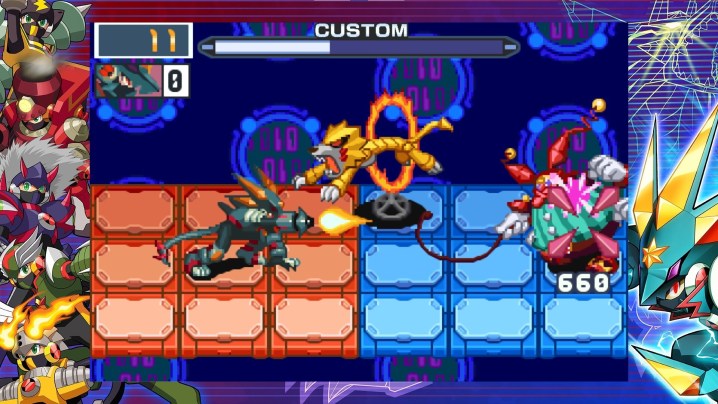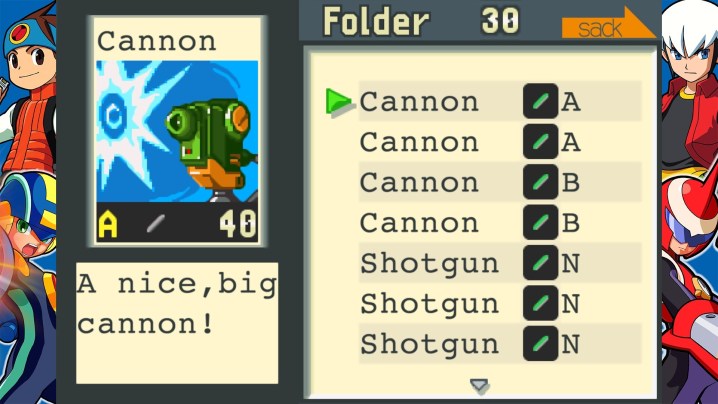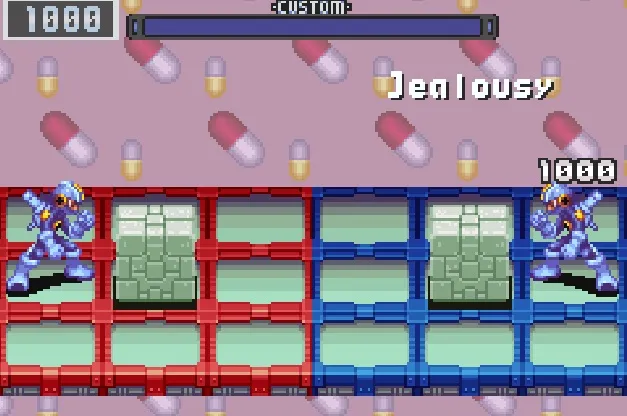Imagine that your Nintendo Switch didn’t have the ability to connect online and that the competitive game you’re currently playing only supported local multiplayer. It’s a little hard to picture in 2023, right? That’s what Mega Man Battle Network fans had to deal with during the early 2000s. If you wanted to have a battle with your friend during Nintendo’s Game Boy Advance days, they’d have to be within your immediate vicinity and have a Link Cable available to connect two GBAs.
The card-based strategy series spanned six games across the Game Boy Advance, none of which would feature online play (its final game, Mega Man Battle Network 6, was released in 2006). That roadblock didn’t stop fans from building a thriving competitive scene, though. A home-grown esports community surrounding the franchise, called N1 Grand Prix or N1GP, has been growing almost over a decade later thanks to a dedicated community that took online play into its own hands.
After nearly two decades of workarounds, it seemed like life was going to become much easier for competitive players. When Mega Man Battle Network Legacy Collection was announced for PC, PlayStation 4, and Nintendo Switch, the fanbase was hopeful that the re-release’s added online play would take the competitive scene out of the shadows and draw in new players.
The community started from scratch to create its own emulator with online features that many fighting game fans pine for. With the release of the remastered collection, N1GP feared that all the work put into creating that tool would go to waste. To their surprise, it turns out that the grassroots solution would continue to be the preferred way to play competitively while still coexisting with Capcom’s official release.
Let’s tango
Mega Man Battle Network 6’s competitive scene started to gain a bit of traction in the late 2000s through an open-source emulator called VBA Link 1.8. The tool was handy because it was compatible with the Game Boy Advance Wireless Adaptor, but it was so old that no one could make adjustments to it. The emulator’s source code was lost and some games simply ran like garbage on it. It wasn’t an ideal way to play, but fans had few options at the time.

Because there wasn’t an easy way to obtain the game or play it online, many hopeful enthusiasts felt discouraged from continuing the budding competitive scene. Then in 2015, a fan named MegaMasterX started the N1GP while bored at work one day. It began with a simple Skype group and now the community is fast approaching 10,000 people globally today.
The very first N1GP tournament didn’t go as smoothly as desired, with constant disconnects and long lag times. “If there was any sort of issue with the connection between two parties, or if someone was in a country with bad internet, the online battles would have players basically playing your matches at 8-15 fps,” MegaMasterX tells Digital Trends (all community members we spoke to for this piece chose to be known by their usernames). However, that didn’t stop him, as he continued to host makeshift tournaments.
For the next several years, N1GP used the VBA emulator until developer Weenie released an emulator called Tango in April 2022. Tango revolutionized the competitive scene with its various features, including rollback netcode, automatic replays of all matches, and automatic ROM patching.
I have students at the local high school I work at asking me about Mega Man Battle Network, in 2023!
That long journey would see a significant announcement during a June 2022 Nintendo Direct, where Capcom revealed that it was bringing the series to Switch via Legacy Collection. As fans eagerly waited for more details about the collection and what sort of features it would have, it created a bittersweet moment within the community. Tango had been announced and released only a few months earlier than BNLC’s reveal, leaving players to question the future of a tool that had been painstakingly developed to solve a problem. The assumption was that Tango would be made obsolete considering every game in the package would feature online play.
That wasn’t the case; BNLC has only made the competitive scene and Tango more accessible than ever.
Coexisting tools
BNLC would be an important release for a long-dormant series. It opened up the franchise to a much wider modern audience – especially since the original games tended to be solitary experiences that required a form of local connection. The remasters would also launch on multiple platforms, including PlayStation and PC, rather than just on a Nintendo system (though they could still be enjoyed portably on Switch or Steam Deck).

It marked a big moment for those who missed the MMBN franchise back when it was first released. N1GP moderator SoulXCross exclaims, “But this release, and the marketing that went into it, is huge. People see it! I have students at the local high school I work at asking me about Mega Man Battle Network, in 2023!”
The community members I spoke to noted that they often hear about how fans of the series that always wanted to be able to battle and trade worldwide were completely unaware that NG1P even existed (some newcomers even demanded to know why nobody told them that the franchise had such an active community!). Fans all across the globe had been fiending to pick their controllers back up again and they were just waiting for the beacon — BNLC — to be lit.
With an official online play on the horizon, Weenie announced that he would be winding down support and development on the Tango emulator in favor of official netplay with BNLC. It turned out that all his work wasn’t for naught, though. When the collection launched, he discovered that the Steam version actually works with Tango, making the emulator much more accessible than ever before. Players who are interested in the competitive scene and trying out Tango can simply buy the games instead of trying to download shady roms from the internet and load it into Tango to enjoy its features.
Due to the emulator’s suite of features, it’s still the preferable option to play competitively as opposed to just playing it via the Steam launcher. BNLC uses a delay-based net-play solution instead of rollback. “It’s likely that N1GP will continue to use Tango for the long haul for a lot of the quality of life features it has, like automatic replays and balance patches,” Weenie tells Digital Trends.
Lingering pain points
Even with the ease of access between the Steam version and the Tango emulator, there are still some issues with BNLC, creating more need for community innovation. The elephant in the room is the lack of cross-play between platforms. As a result, N1GP moderator HonorNite expects that there will be certain niches across each PC, PlayStation, and Switch. Many players will undoubtedly play the game on Nintendo Switch due to its portability factor; it’s much easier to host in-person tournaments on the Switch as opposed to using any other platforms at local events.
That platform separation compounds with another barrier for its competitive scene. These games are RPGs where players have to build their own competitive setup. It’s not like a fighting game where players only have to bring a controller and their skills to a tournament. Building a proper competitive kit requires a time investment; players need to play through an entire game’s story and post-game content just to get the numerous battle chips and the correct chip codes.

Since there’s no crossplay or even cross-save in the collection, many players will most likely choose to stick with one platform. That’s one area where Tango remains useful. The emulator works with the Steam version itself, and players can just insert in completed game saves that allow for immediate access to all the tools needed to build a strong competitive folder without having to play through the entire game. Many community members, like HonorNite, advocate for emulation in cases like these since it’s incredibly easy to load 100% completed PvP-ready save files onto Tango (it can also play on most Windows, Linux, and Mac devices).
“The lack of crossplay is saddening, but we will make do with what we have,” HonorNite tells Digital Trends. “I believe that each platform will have its own pocket community within the greater MMBN PvP community, and those communities will host tournaments for their respective platforms.”
Retrofit
Tools like Tango are still preferable because of another issue they solve: There are only a few select entries in the series that are normally worth developing a competitive scene around because of how wildly each game’s combat balance varies from one another. In particular, the last entry, Battle Network 6, has by far and away the most robust one. N1GP community manager Salad notes that it’s because the title is the culmination of six games’ worth of design experience from Capcom. Simply just playing it reveals the careful thought that the team behind the game put into the PvP experience.
“With such a strong framework, enough counter-play and interaction exist that the game has never really fallen into a stale state, even without balance updates!” Salad tells Digital Trends.

There’s a misconception that Battle Network 3 would be one of the most popular entries in regard to PvP, but that’s only because its single-player campaign is highly lauded as the best of the six games. In reality, BN3 is considered to have one of the most frustrating PvP experiences out of the entire series. That’s because it’s incredibly unbalanced, with easily exploitable mechanics. Mars, another N1GP moderator, aimed to fix that by creating the “Balanced Battle Network 3” mod that works exclusively with Tango. This patch backports some features from later games in the series, such as how wind elemental attacks dissipate barriers, as well as toned down the power of certain Battle Chips.
As for the other entries in the franchise, opinions are mixed on whether the older games can develop serious competitive scenes. Without extensive balance changes and ban lists for certain overpowered Battle Chips, experiencing competitive matches with the first three games is like watching paint dry. Others think that the older games would be fun to dabble in from time to time. There will always be people in niche communities unhinged enough to try them out.
“I hope they find each other. Beyond any ambiguity, I wholeheartedly wish that their numbers flourish and that the matchmaking for all of the games is always active,” Mars says.
There has never ever been a better time to be a fan of Mega Man Battle Network.
Despite some lingering issues that BNLC comes with, the future looks bright for the Mega Man Battle Network community. Not only will the remastered collection likely widen its membership, but the homegrown work that previous members of the community did will continue to endure. Tango and N1GP are the foundations of the competitive scene and in some aspects have outdone Capcom itself. However, they are flexible enough to work alongside the publisher’s official release and that coexistence is what makes the situation so special.
“I really want to give credit to the people who volunteer their time to organize events, compile and create documentation and content, and manage the N1 Grand Prix community. A lot of people put in a herculean effort to keep things running,” says MegaMasterX. “There has never ever been a better time to be a fan of Mega Man Battle Network.”
Editors’ Recommendations
Services Marketplace – Listings, Bookings & Reviews